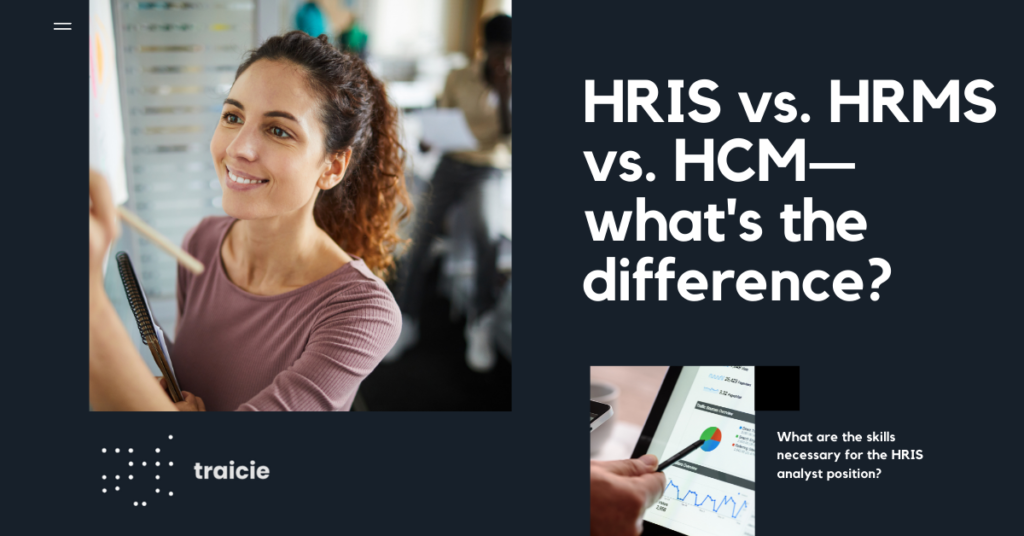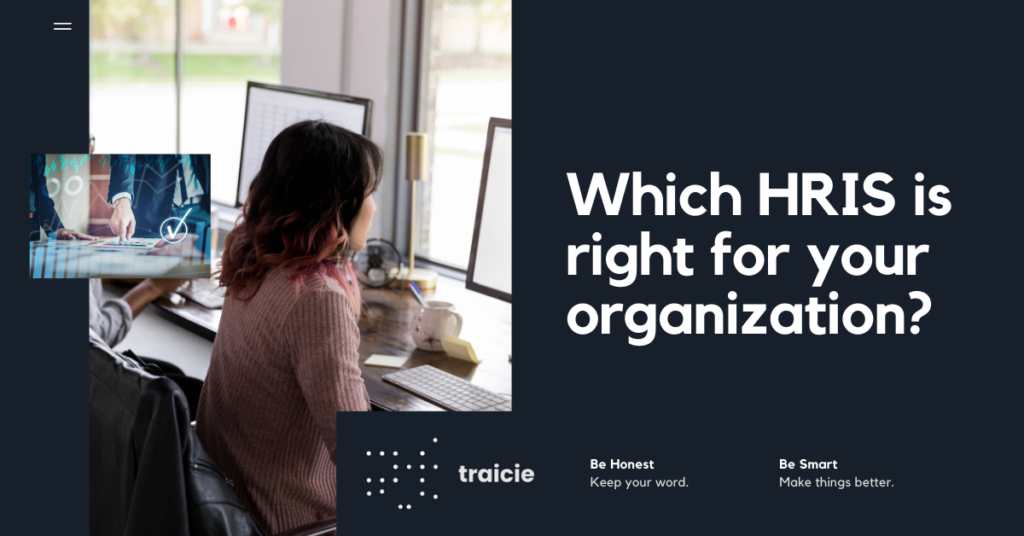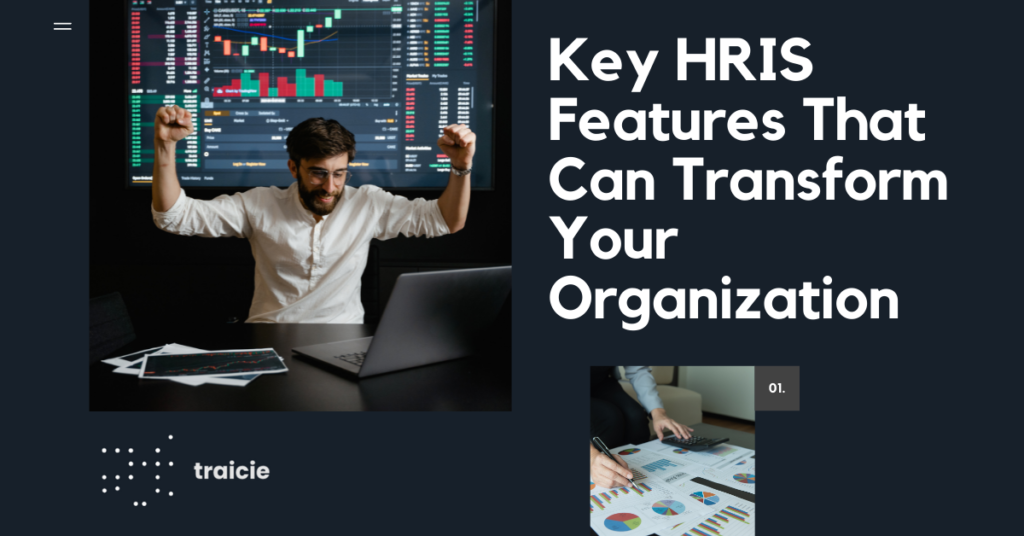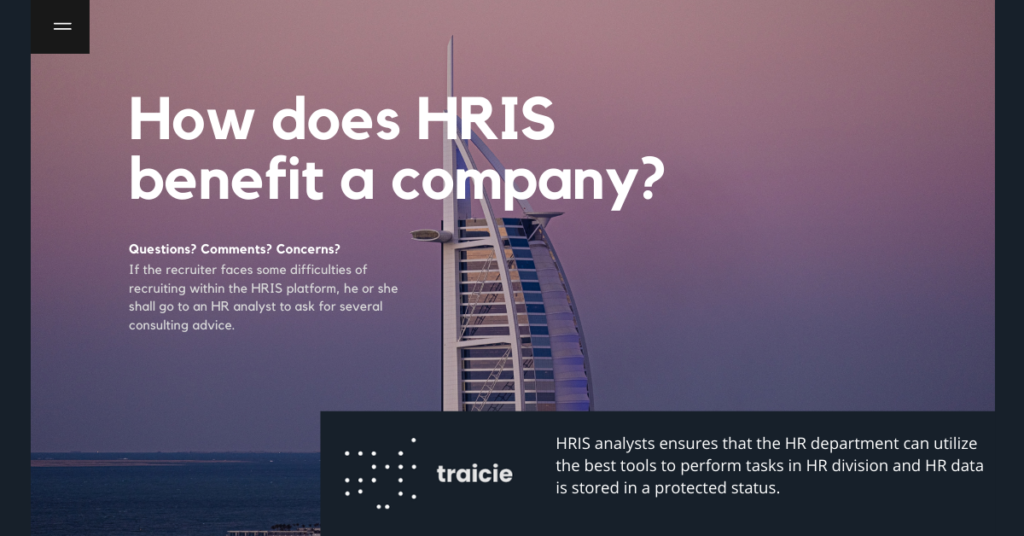What Is HRIS Systems? Everything you need to know about the systems – Human resource information systems and how you can pick the right one for your company, organization. Also traicie HRTech will explain to you in this article the main different between: HRIS vs. HRMS vs. HCM, How many Functions/ Features of a HR Information System have for you in order to manage your human resources
What does HRIS Systems stand for?
HRIS stands for human resources information system. Initially, this referred to a simple system for keeping administrative employee records. HRIS has evolved to include processes such as talent acquisition, recruitment, and ongoing employee data management and processing as HR functions have become more complex.
Main different between: HRIS vs. HRMS vs. HCM.
Human capital management (HCM), human resources management system (HRMS), and human resources information system (HRIS) are frequently used indiscriminately. However, due to the development of more advanced technology, there are minute distinctions between these 3. Human resources (HR) solutions and HRMS evolved through time into a more data-management oriented HRIS, which in turn gave rise to the more comprehensive and strategic, employee-focused HCM of today.
HRMS
Human resources management systems (HRMS) came into usage when firms started to do their HR functions using more complex software and automated operations, while it is still used interchangeably with HRIS. Payroll management and time and labor may be included in the HRIS of nowadays.

HCM
This relates to a comprehensive solution that addresses all facets of workforce management and the HR function. Advanced talent management functions like performance management, succession planning, pay planning, strategic workforce planning, and many other HR planning activities are included in the additional capability. HCM includes all HR operations, whether they are transactional, strategic, or data-based.
What does an HRIS do and benefits? What are 5 different types of HRIS?
Employers may discover that HRIS benefits them in the following ways in addition to increased staff productivity:
| Improve user engagements | Application for jobs, benefit enrollment, and other HR procedures may be made simpler by HRIS with user-friendly interfaces and mobile apps. As everything runs more smoothly with good HRIS systems, employees’ perceptions of the business will also improve. From their laptops or phones, employees can easily seek leave, look up contact details, and check their paychecks. |
| Reduce time-consuming tasks | The labor expenses related to payroll, attendance management, and other manual administrative tasks may be reduced by using common HRIS technologies including automation, analytics, and artificial intelligence. You are merely merging all of your company’s HR operations into a digital system with HRIS. This covers a broad range of information about people and is frequently utilized by both employers and employees for a variety of reasons. |
| Support for company expansion | Cloud-based technology is frequently able to handle growing workforces, volumes of transactions and data, as well as geographic expansion. Typically, new hires are made to fill positions left open by more seasoned workers. The remaining employees must scurry to fill the leaving employee’s shoes and their own until a new team member can be hired and trained when an employee leaves or is fired. Because your staff suddenly has more work—but not more money—morale ultimately falls. |
| Sustain compliance | An HRIS enables you to quickly find, hire, and train new employees so they can successfully take on their new positions. Improved initial onboarding and ongoing training will increase staff output, lower attrition, and increase efficiency. |
| Regulations | Might differ significantly from one place to another and are continually changing. Some HRIS suppliers include monitoring systems for keeping up with evolving laws and data security controls to assist stop incidents. Good HRIS vendors keep their systems updated with the most recent legal changes that may impact your company. For global organizations, finding a provider with multi-country presence and experience is crucial if they desire to maintain compliance. |
What are 5 different types of HRIS?
HRIS provide the benefits of automation, self-service, centralized databases, and talent management to assist HR professionals in performing their functions to the best of their abilities, ultimately benefiting the organization. Aside from that, each type of HRIS systems has a unique series of characteristics.
| No. | Types of HRIS System | Description |
| 1 | Operational HRIS | Human resource data such as personnel files, position details, and performance review info are collected and reported by operational HRIS systems. Operational HRIS systems can help with standard HR functions in a wide range of businesses. They are used to assist HR managers in gathering the information they require to perform tasks such as performance management, promotions, hiring, and internal personnel changes. |
| 2 | Tactical HRIS | Tactical HRIS systems are involved in resource utilization processes. This contains hiring people, mentoring, compensation, and vacancies, among other things. These are more useful for making large-scale choices regarding resource allocation, job analysis, and development. Tactical HRIS systems deal with data other than internal statistics, such as union information, competitor data, government requirements, and so on. Tactical HRIS systems are best suited for organizations that require assistance in making macro-level decisions about what to do with resources, rather than those that require assistance with smaller day-to-day duties. |
| 3 | Strategic HRIS | Assist with strategic planning and judgement call. They aid HR professionals in tasks such as goal setting and prospective labour force planning. Strategic HRIS systems can assist with workforce knowledge and appropriate workforce planning by managing data such as market data and operations expenditures. Strategic HRIS systems are especially useful for organizations looking to strategically broaden or develop. Consider a strategic HRIS if you want to rely on concrete figures to make intelligent, strategic, data-driven decisions for your company’s future. |
| 4 | Comprehensive HRIS | A comprehensive HRIS is a hybrid of the above kinds, encompassing all aspects of HR, including implementation, strategic, and strategic issues. These serve as a streamlined data set and framework for the simple evaluation and strategic planning of a wide range of HR-related tasks. A comprehensive HRIS serves as a one-stop shop for stashing and displaying all information required to perform almost all HR activities. While they may be more expensive or require more training and resources to operate, comprehensive HRIS systems can provide a plethora of useful features that can ultimately transform how an HR department operates. |
| 5 | Limited-function HRIS | A limited-function HRIS, as opposed to a comprehensive HRIS, serves a single purpose. They are not designed for business strategy or management. Rather, their roles are more specific and discrete. The precise function of each limited-function HRIS is determined by the system. For instance, an HRIS could be primarily designed for employee training or benefit management. Limited-function HRIS systems are generally better suited for smaller businesses because they are often cheap, simple to use, and can be used throughly by an only one HR manager. |
| >>> You might wonder: How to become HRIS analyst: jobs description, salary, skills [Updated 2022]
Which HRIS is right for your organization?
How to choose the best HRIS for your business?

| Step 1: Determine the Organization’s Requirements | Identifying organizational and departmental needs will be a company-specific endeavor. At this point, the firm’s particular guidelines will ascertain which features are required versus which are desired. Sometimes an HRBP HR Business Partner can consult the best for you Many organizations will start with either an integrated payroll module or an HRIS that will work with the existing payroll system. You might think about integrating an applicant tracking system, a performance management system, or a time and attendance system. A benefits module is a good addition for many organizations due to the ever-increasing complexities of benefits administration. You can use these modules to enroll employees, track and process benefits enrollments and participation for the organization, and generate required notices. |
| Step 2: Analyzing Available Vendors in Relation to Your Company’s Needs | After you’ve created an expert set of specifications and project constraints, you should create rating criteria to assess the features and limitations of the products you’re considering. Enumerate your specific needs and requirements on the left edge of the spreadsheet, and then add the distributors and products you’ll be evaluating on the right. |
| Step 3: Establish a budget. Ask vendors the below questions: |
What HRIS capabilities are available? What security precautions are in place? How and where is info stored? How the HRIS interacts with the processes you already use The accessibility of technical assistance The total cost of the HRIS, which includes the initial fee, subscription fees, execution fees, and maintenance fees. The HRIS’s Return on Investment |
| Step 4: Request for a proposal | You should send each vendor on your list a detailed RFP seeking bids for your company. Vendors must meet the minimum requirements you’ve set and be willing to hold a price point for up to 90 days. The RFP should involve information about your company along with project specifications such as minimum requirements, budgetary constraints, and a timeline for selection and implementation. Organizations should issue RFPs to at least four vendors because some vendors may be unable to meet your specific requirements in some way. |
| Step 5: Participate in demos | Select no fewer than three vendors to come onsite to present a demonstration after receiving the RFP responses. The length of time you should schedule for the demonstration will depend on the complexity of the system and your list of minimum requirements. Ensure that each project committee member is able to attend the presentations and ask pertinent questions. Create a checklist (scorecard) for the demonstration using the list of minimum requirements to ensure that each item is fully answered. |
| Step 6: Implement & Tracking results. | Conduct reference checks once you’ve narrowed your list of systems down to your final candidates. The finalist vendors should be able to provide you with a list of current clients who are currently using the product. Following your reference checks, you should reconvene your selection committee one last time to review the reference check results alongside the original scorecard results. The final provider candidates should be measured against each other during this meeting, and the team should be able to make a selection decision at this point. Following a decision, you can make the appropriate recommendation to the organization’s senior executives, complete with a demonstration highlighting the purchase’s rationale and the economic benefit by the software. |
The assessment may also include some or all of the desired items from the original organizational needs evaluations list, which may utilize as “tie-breaker” items during the assessment process. Members of the committee should take advantage of this opportunity to ask questions and thoroughly investigate any aspects of the software that may pose challenges or difficulties. Members of the selection committee should meet shortly after the final demonstration to debrief.
Throughout this debriefing, committee members share their scorecard results and raise any concerns. Members will also discuss how the software meets or exceeds the organization’s requirements. Certain vendors may require follow-up conversations or queries.
HRIS Systems: Functions/ Features
An HR dashboard is a business intelligence tool that enables Human Resource groups to record, evaluate, and submit on HR key performance indicators (KPIs). Modern, interactive dashboards make use of an HR analytics platform, which allows for the easy combination of data from all systems and deep exploration of this data directly within the dashboard.

This allows HR teams to quickly uncover insights that will improve recruiting, optimize workplace management, and boost employee productivity. HRIS Systems helps:
| No. | Features | Functions |
| 1 | Recruiting & Hiring | Recruiting & Hiring page for job placement ads, as well as a company hiring page, which includes the status of your job openings, the amount of applicants,, job descriptions, the manager engaged, posting date and time, its current status, and your career website. |
| 2 | Employee onboarding | Employee onboarding – it entails developing an onboarding process for administrators and new employees. During the setup process, an administrator can select from a list of approved third-party applications to be distributed to the employee. |
| 3 | Payroll integration | Payroll integration – HRIS can connect directly to electronic time and attendance and ensure compliance with federal, state, and local wage and hour laws. They help employees understand their pay, benefits, and overall compensation. |
| 4 | Compensation management | Compensation management – it entails the task of establishing appropriate wage and salary levels, managing raises and promotions, and incorporating bonuses and other compensation incentives. |
| 5 | Time and attendance | Time and attendance – HRIS programs, like payroll, will either have their own time and attendance module or will connect to a time and attendance product via an API. |
| 6 | Leave and time off management | Leave and time off management – it can request time off for vacations, sick days, PTO, injuries, disability leave, school meetings, bereavement leave, family and medical leave, and even sabbaticals. Most businesses have a system in place for employees to request time off. An HRAS system ensures that your process is operational. |
| 7 | Benefits management | Benefits management – assists employees in making benefit decisions, such as selecting plans and naming beneficiaries. |
| 8 | Performance management | Performance management – Modules for performance management allow for both employee self-assessment and manager review. The system will notify and remind the administrator, manager, and employee of their progress. |
| 9 | Learning management systems | Learning management systems – give trainees easy access to requisite lessons, personalized recommendations, and coworker consultations. Employers can use campaign analytics to improve effectiveness and launch one-time or triggered campaigns to deliver the right learning at the right time. The capability to monitor training progress and completion is extremely useful. |
Why do companies need an HRIS analysist?
What does a HRIS analyst do?
An HRIS analyst’s task is to gather data and distribute it to others in the organization in the form of suggestions and reports. The information gathered is generally about employee productivity, attendance records, salary information, and workforce development. The effective control and presentation of all aspects of HR functions is critical for success as an HRIS analyst.
The HRIS system is made up of computer software programs that are used by human resources (HR) departments to manage payroll and employee information such as benefits. It may also be included in other software used by a company for a variety of internal operations. As a result, most analysts work under strict confidentiality agreements.

HRIS analysts must typically be able to collaborate with other human resource employees and information technology departments to provide the information they require. This data will guide the information tech department in providing the appropriate resources to employees, as well as any project or equipment upgrades that may be required. Other departments may use these reports to make operational changes or to ensure that the company is following human capital laws.
A position as an HRIS analyst assistant may be available to college graduates as a form of internship or from within the HR departments of the organization. Before having the chance to be promoted, an assistant often spends 12 to 18 months learning job duties and skills from the head assistant. The future HRIS analyst will pick up knowledge of software, communication, and data filing throughout this period.
HRIS analyst salary – career path
The steps listed below are typically needed to start and enhance your career as an HRIS analyst.
- Acquire a Degree: A Bachelor’s Degree in Business Administration or a related field is usually required to begin your HRIS Analyst career path in order to remain a competitive option for employers. Concentrate on industry-specific skill development during your education to be well-prepared when applying for entry-level positions and entering the labor force. Before entering the workforce, a HRIS Analyst internship may be required to earn your Bachelor’s Degree and gain necessary on-the-job skills.
- Choose a specialty in your field and apply for an entry-level HRIS analyst position: You may be required to select a specialty within your field as a HRIS Analyst. Determine which aspect of the HRIS Analyst field you are most comfortable with, and continue to take active steps toward developing your chosen HRIS Analyst specialty.
- Increase your HRIS analyst career potential: There are several HRIS Analyst career path levels to advance into after entry-level. It can take up to two years as an entry-level HR analyst to advance to the position of senior HR analyst. To advance in your HRIS Analyst career path, each advanced HRIS Analyst position requires approximately 2 years of experience at each level. To advance your HRIS Analyst career, you may need to obtain additional education, an advanced degree such as a Master’s Degree in a related field, or special certifications.
Here are a few quick compensation examples depending on company and geography:
| Uline | VARITE Inc. | Heinsohn Business Technology | Panasonic Corporation | Jackson Lewis | |
| United States | 88,518$ | 89,282$ | $117,684 | $103,436 | $99,474 |
Top HRIS Certifications
How long does it take to learn HRIS?
Your HR certification is a significant achievement, and the value it brings to your company justifies a higher salary. In reality, employees with an HR certification earned over 32% more than those without a certification in 2021.
If you’re up for a promotion, an HRIS certification will help you stand out from the crowd and show that you’re prepared to take on more responsibilities.
| HRIS Certificate | Required |
| Human Resources Information Program (HRIP) certification | 60 recertification credit hours are required during the three-year period beginning with the date the certification is permitted, |
| A Professional in Human Resources (PHR) certification | Possess a master’s degree or higher and at least one year of experience in a professional-level HR position.Possess a bachelor’s degree and at least two years of experience in a professional-level HR position. ORPossess at least four years of professional-level HR experience. |
| A Professional in Human Resources—International (PHRi) certification | Possess a master’s degree or its equivalent globally, together with at least one year of experience in a professional-level HR role.Possess a bachelor’s degree or its equivalent internationally and at least two years of experience in a professional-level HR role, ORPossess at least four years of professional-level HR experience. |
| The Global Professional in Human Resources (GPHR) certification | Have a master’s degree or higher and at least two years of experience in a professional-level HR position.Have a bachelor’s degree and at least three years of experience in a professional-level HR position. ORHave at least four years of professional-level HR experience. |
- The Future of HRIS
The adoption of HRIS software-as-a-service or an on-premise HR system is rapidly becoming the routine. With the widespread adoption and acceptance of this type of system, accessing HR information from anywhere is becoming increasingly simple. To capitalize on this brave new world, we need futuristic vendors who are versatile and agressive in order to achieve, as well as HR professionals who are driving the need. HRIS is expected to double over the next two years, which may have ramifications for how workplaces and staff interact in a variety of ways.
Do you know that traicie’s tools can help HRBP in strategic operational value in recruiting process for term of:
- Cost of a job board- Reduce annual spending on job boards
- Cost of HR’S tools – Reduce the cost of surveys and assessment tools.
- Recruitment costs – Reduce selection costs
- Internal mobility – Fill more skilled jobs with internal staff
- Time to hire – Reduce the number of days a role goes unfilled.
- Salary costs – Reduce overall salary costs
- Attrition – Reduce the rate of turnover
- Recruitment cost – Reduce the general recruitment cost